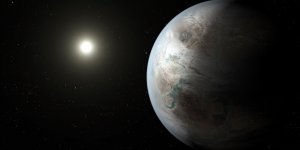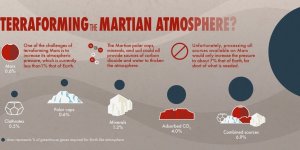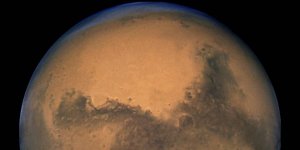Space

Scientists have identified a group of planets outside our solar system where the same chemical conditions that may have led to life on Earth exist. »

Astronomers using ALMA and NOEMA have made the first definitive detection of a radioactive molecule in interstellar space. The radioactive part of the molecule is an isotope of aluminium. »

Science fiction writers have long featured terraforming, the process of creating an Earth-like or habitable environment on another planet, in their stories. Scientists themselves have proposed terraforming to enable the long-term colonization of Mars. »

The moon could have supported life during two windows of its history, four and 3.5 billion years ago. »

For the first time ever, scientists using NASA’s Fermi Gamma-ray Space Telescope have found the source of a high-energy neutrino from outside our galaxy. »

Data collected by NASA's Juno spacecraft using its Jovian InfraRed Auroral Mapper (JIRAM) instrument point to a new heat source close to the south pole of Io that could indicate a previously undiscovered volcano on the small moon of Jupiter. »

SPHERE, a planet-hunting instrument on ESO’s Very Large Telescope, has captured the first confirmed image of a planet caught in the act of forming in the dusty disc surrounding a young star. »

The new results suggest that `Oumuamua is most likely an interstellar comet and not an asteroid. »

Two independent teams of astronomers have used ALMA to uncover convincing evidence that three young planets are in orbit around the infant star HD 163296. »

NASA's Curiosity rover has found new evidence preserved in rocks on Mars that suggests the planet could have supported ancient life, as well as new evidence in the Martian atmosphere that relates to the search for current life on the Red Planet. »

Ever since NASA's Voyager 1 spacecraft flew past Jupiter in March, 1979, scientists have wondered about the origin of Jupiter's lightning. »

An international team of researchers have identified ‘fingerprints’ of multiple metals in one of the least dense exoplanets ever found. »

Scientists have found traces of fatty acids - key building blocks of biological cells - in acidic streams in the UK, which they say hint that life may once have existed on Mars. »

Rising levels of planet-warming gases may reduce key nutrient levels in food crops, according to a new study. »

Astronomers have used observations from the Atacama Large Millimeter/submillimeter Array and ESO’s Very Large Telescope to determine that star formation in the very distant galaxy MACS1149-JD1 started at an unexpectedly early stage, only 250 million years after the Big Bang. »

Interstellar space is mostly a vacuum, so there is no medium that can carry sound. In other words, space is totally silent. But astronomers have often associated the movement of heavenly bodies with music. »

Astronomers using the NASA/ESA Hubble Space Telescope have detected helium in the atmosphere of the exoplanet WASP-107b. This is the first time this element has been detected in the atmosphere of a planet outside the Solar System. »

Far across the solar system, from where Earth appears merely as a pale blue dot, NASA’s Galileo spacecraft spent eight years orbiting Jupiter. The mission ended in 2003, but newly resurrected data from Galileo’s first flyby of Ganymede is yielding new insights about the moon’s environment — which is unlike any other in the solar system. »

The ALMA and APEX telescopes have peered deep into space — back to the time when the Universe was one tenth of its current age — and witnessed the beginnings of gargantuan cosmic pileups: the impending collisions of young, starburst galaxies. »

More than halfway across the universe, an enormous blue star nicknamed Icarus is the farthest individual star ever seen. »

Researchers were surprised when they uncovered a galaxy that is missing most, if not all, of its dark matter. An invisible substance, dark matter is the underlying scaffolding upon which galaxies are built. It's the glue that holds the visible matter in galaxies — stars and gas — together. »

The first interstellar object ever seen in our solar system, named ‘Oumuamua, is giving scientists a fresh perspective on the development of planetary systems. »

Observations of Ceres have detected recent variations in its surface, revealing that the only dwarf planet in the inner solar system is a dynamic body that continues to evolve and change. »

Astronomers have used NASA's Hubble Space Telescope to uncover a vast, complex dust structure, about 150 billion miles across, enveloping the young star HR 4796A. »

Data collected by NASA’s Juno mission to Jupiter indicate that the atmospheric winds of the gas-giant planet run deep into its atmosphere and last longer than similar atmospheric processes found here on Earth. »

For the first time, astronomers have detected a signal from stars emerging in the early universe. »

Scientists used NASA’s Hubble and Spitzer space telescopes to find the “fingerprints” of water in the atmosphere of a hot, bloated, Saturn-mass exoplanet some 700 light-years away. »

Several high-tech companies are teaming up on a plan to put a mobile phone network on the moon next year. »

A new analysis of data from two lunar missions finds evidence that the Moon’s water is widely distributed across the surface and is not confined to a particular region or type of terrain. The water appears to be present day and night, though it’s not necessarily easily accessible. »

Three billion miles away on the farthest known major planet in our solar system, an ominous, dark storm – once big enough to stretch across the Atlantic Ocean from Boston to Portugal – is shrinking out of existence as seen in pictures of Neptune taken by NASA’s Hubble Space Telescope. »

In the year since NASA announced the seven Earth-sized planets of the TRAPPIST-1 system, scientists have been working hard to better understand these enticing worlds just 40 light-years away. »

The nearby dwarf galaxy known as the Large Magellanic Cloud is a chemically primitive place. »

Eastern France has experienced unusually heavy rainfall this month and NASA satellite data has helped determine where the largest rainfall occurred. »

A study published this week based on observations by NASA's Mars Reconnaissance Orbiter during the most recent Martian global dust storm suggests such storms play a role in the ongoing process of gas escaping from the top of Mars' atmosphere. »

Saturn's moon Titan may be nearly a billion miles away from Earth, but a recently published paper based on data from NASA's Cassini spacecraft reveals a new way this distant world and our own are eerily similar. »